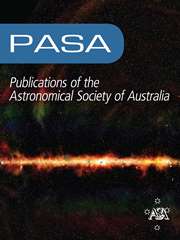No CrossRef data available.
Article contents
Spectral-line performance of low-frequency radio telescope arrays: SKA-Low stations
Published online by Cambridge University Press: 01 April 2025
Abstract
The effects of diffraction, reflection and mutual coupling on the spectral smoothness of radio telescopes becomes increasingly important at low frequencies, where the observing wavelength may be significant compared with the antenna or array dimensions. These effects are important for both traditional parabolic antennas, which are prone to the ‘standing wave’ phenomenon caused by interference between direct and scattered wavefronts, and aperture arrays, such as the SKA-Low, MWA, HERA, and LOFAR which have more complicated scattering geometries and added dependence on pointing direction (scan angle). Electromagnetic modelling of these effects is computationally intensive and often only possible at coarse frequency resolution. Therefore, using the example of SKA-Low station configurations, we investigate the feasibility of parameterising scattering matrices, and separating antenna and array contributions to telescope chromaticity. This allows deeper insights into the effect on spectral smoothness and frequency-dependent beam patterns of differing antenna configurations. Even for the complicated SKA-Low element design, band-limited delay-space techniques appear to produce similar results to brute-force electromagnetic models, and allow for faster computation of station beam hypercubes (position, frequency and polarisation-dependent point spread functions) at arbitrary spectral resolution. As such techniques could facilitate improvements in the design of low-frequency spectral-line surveys, we conduct a simulated Cosmic Dawn experiment using different observing techniques and station configurations.
Keywords
- Type
- Research Article
- Information
- Creative Commons
- This is an Open Access article, distributed under the terms of the Creative Commons Attribution licence (https://creativecommons.org/licenses/by/4.0/), which permits unrestricted re-use, distribution and reproduction, provided the original article is properly cited.
- Copyright
- © The Author(s), 2025. Published by Cambridge University Press on behalf of Astronomical Society of Australia


